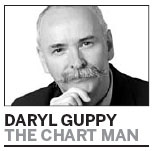Daryl Guppy
Should gold be sold? Precious metal at new low
(China Daily)
Updated: 2011-01-31 15:24
 |
Large Medium Small |

The downward trend in gold has accelerated, making new lows near $1,320. A rally above $1,380 is required before a new upward trend can be confirmed.
A combination of trend-change features has developed and this suggests a downside target as low as $1,260. Understanding the chart-based and technical reasons for the change in the gold trend is not the same as examining the reasons for the trend change. Technical analysis helps identify trend change and establish the potential downside targets. How investors incorporate this analysis into their investment activity depends on their beliefs about the gold market.
Gold is much more than a precious metal. It attracts an emotional reaction unlike any other precious metal. Gold is widely regarded as a hedge against inflation and a hedge against the weakness in paper-based, or fiat currencies. I own up to an emotional attachment to the yellow metal, having mined it underground and panned for it in Australian deserts. I try not to let these emotions interfere with my analysis of gold price behavior.
The price of gold is increasingly influenced by the growing impact of Exchange-Traded Commodity Funds (ETCF). Many of their investors are driven by their emotional feelings about gold.
The funds do not buy gold for jewellery production. They do not buy gold as a way of protecting sovereign currency. The ETCF buy gold because their investors demand the funds buy.
The ETCF also sell gold when their investors want to sell. This is the important difference. The buying and selling activity of the ETCF are driven by their emotional investors, and not by changes in industrial supply and demand or sovereign hedging. The buying or selling is purely a speculative activity. Normally this is not a significant issue in a futures' market. Speculation is required to make it easier to producers and users to match delivery and smooth out fluctuations in supply and demand. The speculative activity is within the trend. It usually does not create the trend.
| ||||
Selling on this consistently large-scale quickly rips the floor out from beneath the price. Large scale ETCF selling, initiated by investors selling their ETCF positions and forcing the ETCF to sell gold, quickly pushes the gold price down. A fall in the gold price triggers more investor redemptions, again forcing ETCF to sell. These are emotional reactions but the new structure of the gold market magnifies the impact of these emotions. The result may be a cascade of falling prices and a very rapid trend collapse as gold is sold.
The sell-off is not in response to any change in industrial demand and supply. It is not driven by sovereign gold sales. It is not created by the activity of short-term speculators and hedgers. This type of sell-off is driven by mandated selling in response to emotional investors closing open positions. It dumps physical supply on the market because these are bullion funds rather than funds built on futures' positions where physical delivery is optional.
Technical analysis identifies the combination of features that confirms a trend change. They include the break below the upward trend line starting from the low in July last year. They also include a change in the relationship between traders and investors. For the first time since July the long-term group of averages tracking investor behavior has moved down.
A better understanding of the changing dynamics of the market structure helps us to decide which of the technically calculated targets are higher probability targets.
The author is a well-known international financial technical analysis expert.
| 分享按钮 |



